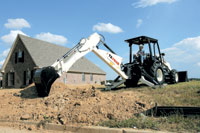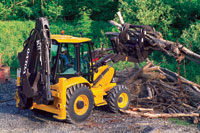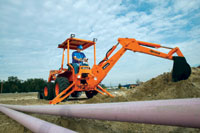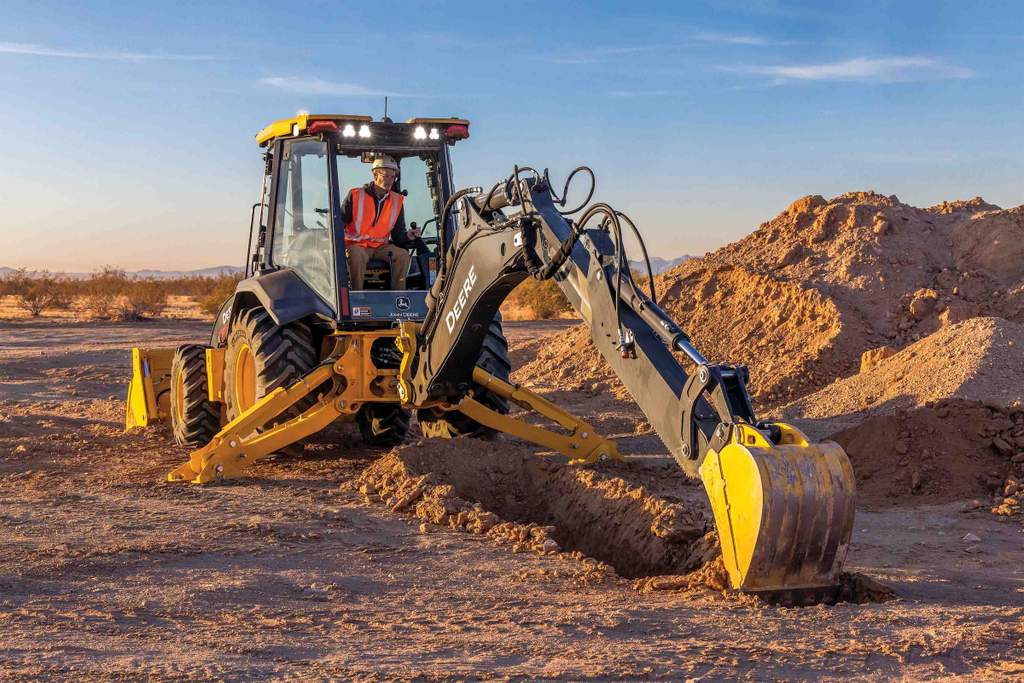The Duality of Loader Backhoes
By simply spinning a seat from steering wheel to joysticks, an operator can have the two basic principles of construction at his or her fingertips — the dual capacities of excavation and carry and load.
On almost any jobsite across the country (from landscape to utility work), dig-and-load operations are a must, and oftentimes the combination of a skid steer and compact excavator fit the bill. However, as jobsites become less accessible with a minimal allowance for equipment and crews, contractors are beginning to look for a single go-to solution — and compact backhoe loaders are filling that niche.
With the addition of a small backhoe to a fleet, contractors are able to eliminate the operating costs of two machines, as well as free up valuable space on an already crowded construction project. While these dig-and-load machines continue to get smaller, their markets continue to get bigger.
“Compacts are a growing section of the backhoe market,” says Jim Blower, mid-range product manager of JCB. “The need for these machines initially came about with landscapers wanting smaller backhoes rather than full-size ones. With time, more and more people are looking at the compact backhoe because they can be productive in those small packages, and it can be towed and transported a lot easier. Plus, the operating costs are a bit lower.”
Compact backhoe loaders are ideal for any application that requires digging and hauling materials. These machines excel in important project tasks such as site preparation and cleanup. Landscapers, as well as residential and commercial construction contractors, find compacts useful in their everyday tasks, digging for utilities, planting trees, building ponds and retaining walls and hauling mulch, gravel, sand and any other spoil or product.
“Contractors can use a backhoe loader to load and unload trucks, to break up concrete and to dig postholes,” says Tom Reith, product manager for Terex. “For example, public and private utilities put backhoe loaders to good use, particularly when it comes to installing or repairing gas, sewer, water, cable TV and fiber-optic lines.”
The compact size of the loader not only allows contractors to use the machine in tight jobsites, but enables easy transportation from one project to the next. Since compact backhoe loaders weigh less than full-size backhoes, they can be maneuvered on smaller trucks and quickly unloaded at a site. This ability is particularly important in times when the machine is needed at a moment’s notice.
“Emergency crews that are used to detect and repair gas leaks use compact backhoe loaders. These machines are able to be pulled behind a truck and unloaded quickly — instead of using a larger truck. Applications like that are enlarging the market all the time,” says Blower.
Backhoe Loader Basics
Compact backhoe loaders are categorized by the dig depth of the backhoe — typically any dig depth less than 14 ft. Any machine with more than a 14-ft dig depth would be considered a full-size backhoe. “Dig depth is generally the most critical factor in determining if a particular backhoe will handle the task at hand, so dig depth is usually the primary category,” notes Bill Gearhart, marketing and product manager for Yanmar Construction Equipment.
To further dissect the compact backhoe loader market, these particular machines can be divided into two categories — sub-compact and compact. Sub-compacts are often defined as backhoes with a dig depth of 6 to 7 ft. These machines are typically used in less intensive applications such as small landscaping work.
|
|
“Sub-compacts are really for light-duty applications — almost like a homeowner who occasionally needs to dig a hole for a tree or something of that caliber,” says Doug Dahlgren, product manager for Allmand. “Typically, they’re light-duty machines with backhoe attachments. Sub-compacts are certainly not intended to be used eight hours a day on a construction jobsite.”
Bigger-size compact backhoes, those with dig depths of 7 to 14 ft, can also assist in landscape and residential work or lend a hand in larger construction projects. These machines can take on tasks in general construction projects, road building, material handling and mining, explains Marcello Bargellini, product specialist with Volvo Construction Equipment.
Dig depth aside, other features of compact backhoes typically include 20- to 60-hp engines, operating weights between 3,000 to 12,000 lbs and carrying capacities up to 3,000 lbs. The loaders are also available in two- and four-wheel drive. Oftentimes, two- or four-wheel drive will help a machine operator determine which loader is best for the project’s demands.
“Four-wheel drive is a very valuable feature because it provides access to work areas that a two-wheel drive machine would have greater difficulty negotiating,” says Reith. “It also improves loader performance by providing additional tractive effort into a pile.”
There are two main boom configurations for compact backhoe loaders — straight and curved. While there has been much debate on which configuration is best, there is no true answer.
“Some promote the curved boom saying they can get down into the hole a little bit deeper, but that’s relative to the geometry and how the machine is laid out,” explains Dahlgren. “If you have a curved boom and your bucket is going down in the hole, the curved joint is out further away from you and you cannot see your bucket. On the other hand, if you have a straight boom and your hole is a little bit closer to your tractor platform, typically you can see more of what’s going on than you can with a curved boom in most applications.”

Since a compact backhoe loader is often used for load-and-carry applications, pairing the right size bucket to the front of your machine is imperative to a productive piece of equipment. Most standard buckets are around 60 to 80 in. The size of a bucket is typically determined by the size of the machine as most manufacturers tend to make buckets slightly wider than the loader itself. Contractors may opt to also use multi-purpose buckets, clamshell buckets and heavy-duty buckets for their specialized applications.
Compact backhoe loaders also have the ability to use attachments besides buckets — like a skid steer or excavator. The majority of loaders on the market today come equipped with a quick-attach system that allows contractors to pair the machine with different attachments such as grapples, brooms and forks. Although it should be noted that there is no universal attachment system, which usually makes switching implements from brand to brand impossible.
|
Avoiding Buyer’s Remorse
When in the market to purchase a compact backhoe loader, it’s important to spec models before buying. Ensuring that a compact machine will be large and tough enough to complete the tasks on your to-do list is the No.1 step before purchasing.
“As with any compact machine, especially backhoes, it’s important to look at what application you’re planning to do,” says Blower. “If you need to lift a bucket of material that weighs 4,000 lbs and you have a compact machine that has a 3,500-lb lift capacity, you’re obviously going to overstress that machine.
“It’s finding the right machine for the job at hand. A lot of people think that since it’s a smaller machine, they can get away with using it on larger tasks. However, don’t try to overwork a compact machine — not only will it not work correctly, the life of the machine will diminish.”
After determining the right size machine for your projects, spec’ing different backhoes is important in order to find the best equipment for your pocketbook. Comparing different models from various manufacturers can be beneficial in finding the model that will meet your needs.
“Safety features and fuel economy are definitely important. Also competitive specs, mainly in terms of lift capacity and breakout forces are important as well,” says Bargellini.
Operator safety and comfort should be taken into consideration when deciding which backhoe to buy. When an operator is expected to work in the machine all day, a comfortable seat and workspace is critical. “For frequent use, get a swivel seat with plenty of foot room to swing from loader to backhoe position,” says Gearhart. In addition to a comfy place to sit, the operator’s controls are best when ergonomically placed and entry into the loader is easily accessible.
Other important factors to consider when purchasing a compact backhoe loader are visibility, traction and overall machine durability. For example, if your projects typically demand long days on construction sites, make sure to purchase a machine that can handle those applications and environments. A sub-compact backhoe, designed primarily for landscape and light-duty work, will not be as efficient in those types of tasks as a backhoe specifically built for construction.
The dualism of dig-and-load applications are needed on most jobsites — whether it’s excavating a landscape to build a water feature or creating a trench to repair utilities. Compact backhoe loaders can take on both tasks in one, versatile package, benefiting a wide range of markets and end-users. Understanding the capabilities of the machine, as well as its unique features, allows a contractor, landscaper or even a homeowner to harness the two essential elements of construction in one sturdy, compact machine.
Pam Stask is assistant editor of Compact Equipment, based in Peninsula, Ohio.

 In North America, it is common for the majority of compact backhoe loaders to come equipped with a center-mount boom. This particular style of boom is a backhoe that’s fixed to the frame of the machine and cannot shift like an excavator. “The boom is fixed in the center of the machine and the loader’s stabilizers are mounted in an angle, extending well beyond the width of the machine,” says Marcello Bargellini, product specialist for Volvo Construction Equipment.
In North America, it is common for the majority of compact backhoe loaders to come equipped with a center-mount boom. This particular style of boom is a backhoe that’s fixed to the frame of the machine and cannot shift like an excavator. “The boom is fixed in the center of the machine and the loader’s stabilizers are mounted in an angle, extending well beyond the width of the machine,” says Marcello Bargellini, product specialist for Volvo Construction Equipment. Preserving Backhoe Productivity
Preserving Backhoe Productivity  3. Listen and Learn
3. Listen and Learn  knocking sounds. If any of these behaviors are exhibited, the machine should bestopped immediately and steps to determine what’s causing the anomaly should be taken. All of these are symptoms of burgeoning problems and should be addressed as such to prevent larger, more costly issues from developing. Remember, any change in operation is a signal that maintenance is needed.
knocking sounds. If any of these behaviors are exhibited, the machine should bestopped immediately and steps to determine what’s causing the anomaly should be taken. All of these are symptoms of burgeoning problems and should be addressed as such to prevent larger, more costly issues from developing. Remember, any change in operation is a signal that maintenance is needed.



Comments are closed here.